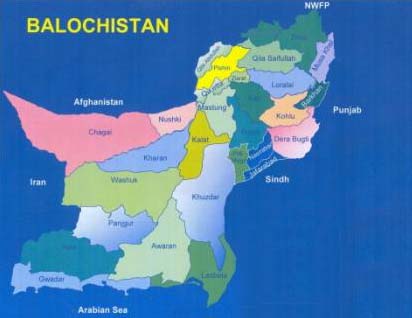

Akbar Mayo
Ongoing clashes between Pakhtun and Baloch students in several educational institutions do not signal good. This is the symptom of the problem. Balochistan is the only province of Pakistan that shares boundaries with the two most strategically important countries of the world: Afghanistan and Iran. At the same time, besides Punjab, it is also the only province that has direct inland connection with all of the provinces of Pakistan. Therefore, the status of Balochistan as a prime strategic location is axiomatic. Representing the five per cent of total population, Balochistan constitutes the 42 per cent of total area of Pakistan. Furthermore, it is also the only federating unit where two significant ethnicities, the Baloch and the Pakhtuns, reside in almost equal proportions. This article aims at highlighting the critical dimensions of relations between both the communities. Though, at the moment both communities are at relative peace, there can be no speculations about peace in future. Each group has a history of wars and feuds, and there exists a visible crack in the socio-economic outlooks of both societies. Before delineating Pakhtun-Baloch relations, it will be pertinent to have a glimpse of the comparative view of their social build-up. The Baloch is a loosely interconnected ethnic group, majority of which is residing in Balochistan. It is divided into two major sub-groups; Sulaimani and Makrani. Contrary to this, the Pakhtuns are more interconnected and divided into hundreds of larger sub-groups. The majority of Pukhtuns resides in NWFP. They are proud of their rich cultural identity. Except few tribes, Pakhtuns speak Pakhto. However, from lingual perspective, the Balochs are divided into several lingual groups in Pakistan: Seraiki speaking Baloch, Sindhi speaking Baloch, Balochi speaking Baloch, Makrani speaking Baloch and etc. In Balochistan, the Pakhtuns are more educated and developed than the Baloch people. Overall, both populations have different socio-economic outlooks. Though, the Pakhtuns have not asserted their presence on the landscape of Balochistan so far, however, the chances of their likely dominance are understandable to anyone interested in the affairs of the province. Up till now, the Pakhtuns have proved to be tolerant towards other ethnicities in Balochistan. They have never resented for Baloch-dominated governance of the province. At the moment, the highest officials of the province, the Governor and the Chief Ministers, belong to the Baloch tribes. Interestingly, since the creation of the office of chief minister in Balochistan, only one Pakhtun held the office only for one year. Currently, out of 38 ministries, 13 are held by the Pakhtuns. And these do not include key portfolios. Despite being comparatively ignored in political terms, the Pakhtun people are happy and want to live in peace. Contrary to this, certain Baloch militant groups have manifested violent resentment to the Pakhtun people. Time and again, the Baloch student federations have created mess at campuses particularly for demanding fixation of quota for the Pakhtun students in all public sector universities and medical colleges in the province. Responding to this, the Pakhtun student federations have stressed for open merit. On the issue of education, two decades ago, the relations between both ethnic groups saw a period of extreme stiffness when an agriculture university was shifted from Kalat to the Pakhtun dominated Pishin. Decision was taken in view of the suitability of land for agriculture experiments and research. However, the move was withdrawn later. Even today, Pakhtun belt has not a single public sector university to name although the Pakhtun students constitute majority of the university students in the province. Similarly, in business sector, the Pakhtuns are restricted to conduct their activities in the areas where it is not possible for the Baloch people to bar them whereas the Baloch businessmen can carry on their businesses freely in Pakhtun areas. Karachi-Quetta highway is the only road that passes through the Baloch areas and on which the Pakhtun transporters can move. However, visiting Yousaf Goth bus stand in Karachi, one finds that not even a single Pakhtun transport company exists to provide travel facilities from Karachi to Gawader. Likewise, whenever ships are unloaded at Gawader Port, one can feel the absence of Pakhtun transport companies carrying goods across country. Last year, education minister of Balochistan was assassinated by a certain Baloch militant group. Though, the event went unnoticed, however the Pakhtuns gravely felt the brutal disappearance of their leader at the hands of the Baloch militant group. Inaction aside, there exist a thinking among the Pakhtuns of being targeted by the Balochs far unjust reasons. While the names of Pakhtun parties suggest that they only breathe for Pakhtuns on this planet, however, their leadership has been silent so far and has compromised the freedom and equality of Pakhtuns. Now two student groups each representing its respective community have started attacking each other. Dozens of students from both sides suffered injuries. Though for the time being FC has been employed to maintain status quo however, no word for the removal of root cause of this prolonging problem has been uttered by leadership of both communities. To conclude, in certain aspects the Pakhtun tolerance towards the Baloch response is a positive sign. However, the perennial compromise of the interests of Pakhtun community may evolve into a volcano of rage and rack the already messy province. Therefore, the leadership of both communities should gauge the underpinnings of contemporary relations between the Pakhtuns and the Balochs and should establish durable basis for lasting peace and harmony between them. Whoever supports anti-Pakhtun attitude must bear in mind that the word Balochistan does not mean that Pakhtuns deserve a secondary status in the province.
No comments:
Post a Comment